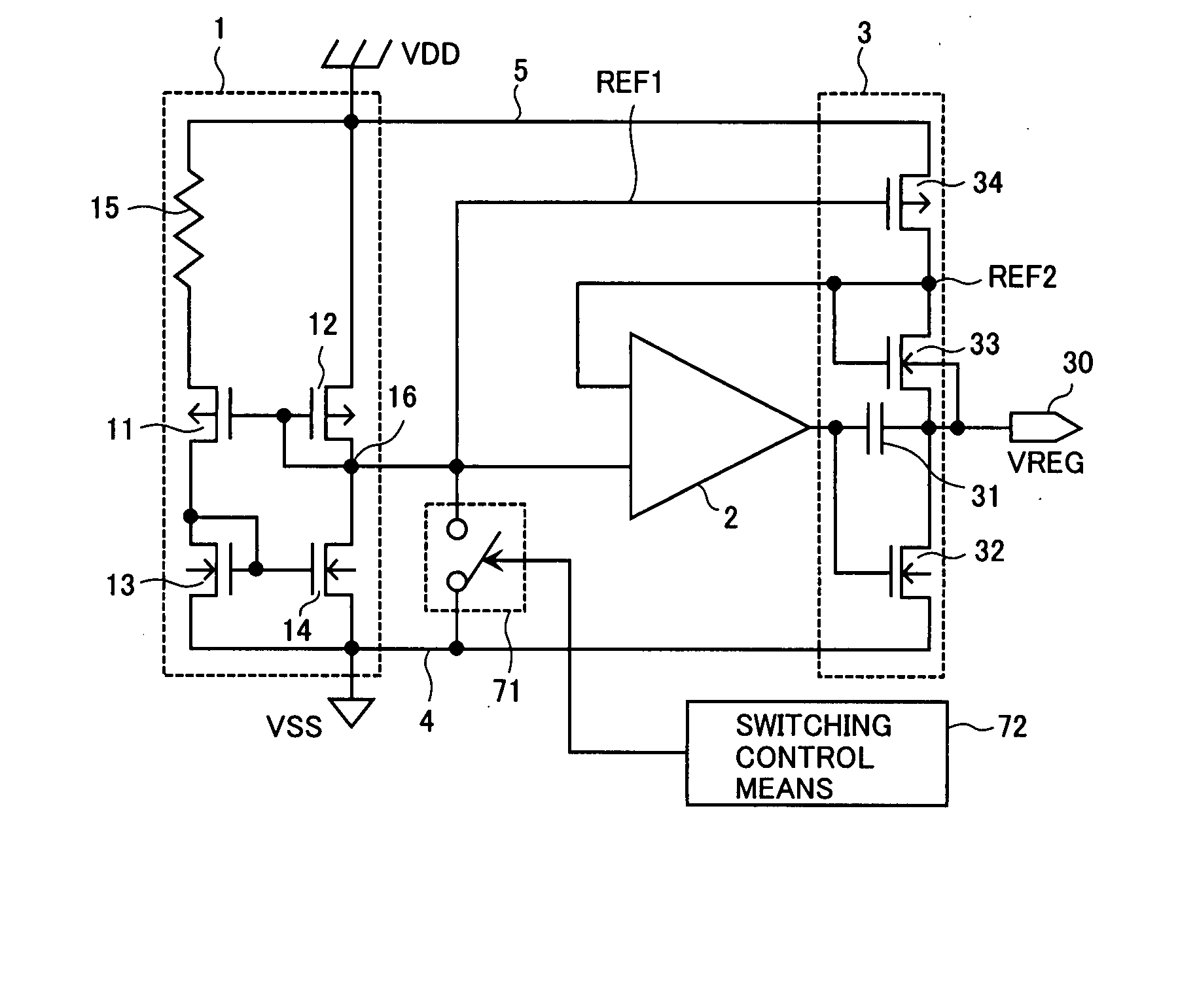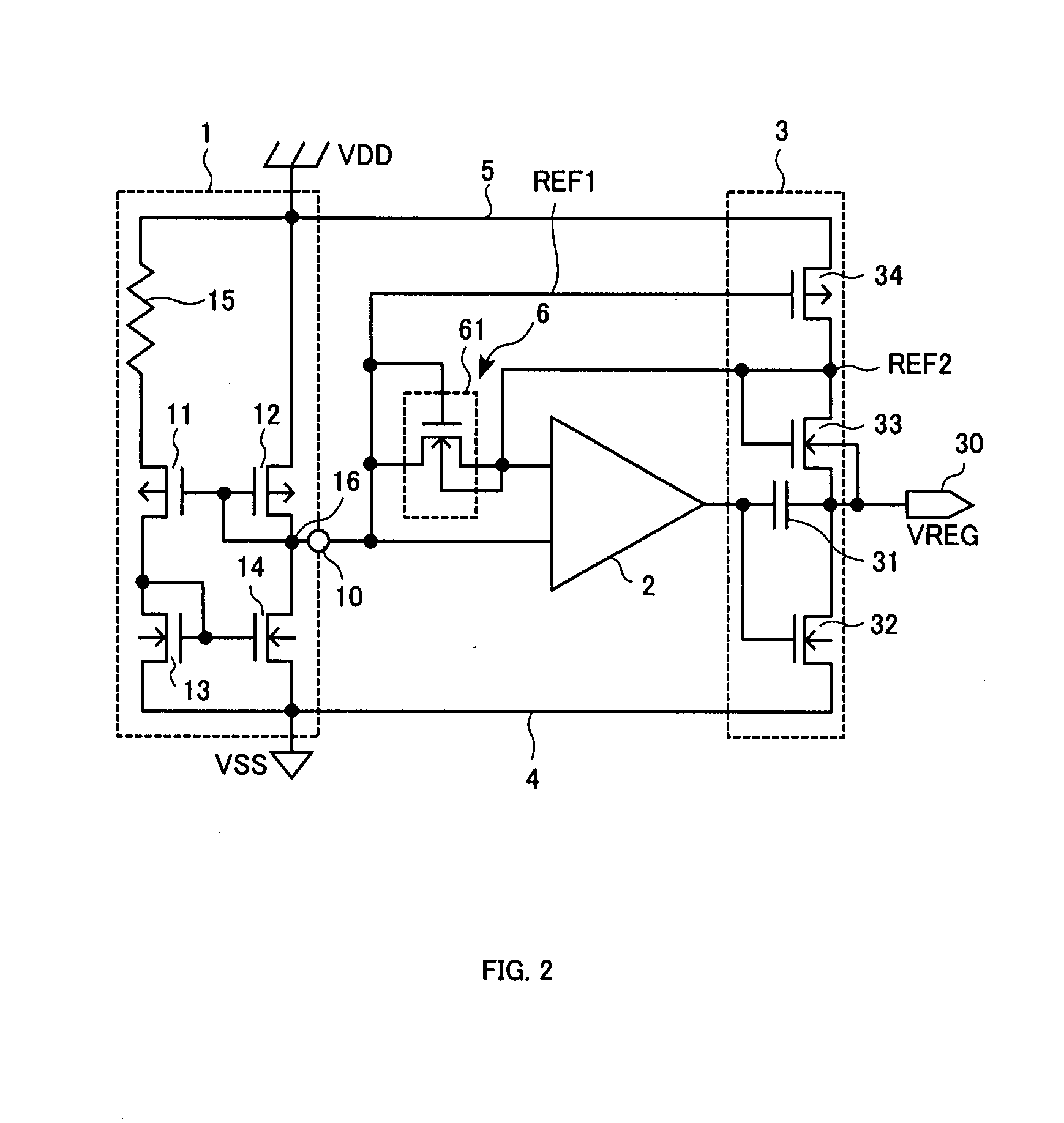Constant Voltage Generating Circuit
a constant voltage generation and circuit technology, applied in amplifiers, amplifiers with semiconductor devices/discharge tubes, instruments, etc., can solve problems such as malfunctions, not giving full stability in some cases, and increasing current consumption at start time, so as to increase the amount, quick stabilize the output potential, and quick stabilize
- Summary
- Abstract
- Description
- Claims
- Application Information
AI Technical Summary
Benefits of technology
Problems solved by technology
Method used
Image
Examples
first embodiment
[0079]FIG. 2 is a circuit diagram showing the configuration of a constant voltage generating circuit in a first embodiment in which the output terminal of a voltage generation source is connected to another input terminal of a differential amplifier for a fixed period of time immediately after the power is turned on.
[0080] As shown in FIG. 2, switching means 6 in the first embodiment comprises an NMOS transistor 61, and the switching between the on-state and the off-state of this NMOS transistor 61 is controlled by the signal (potential entered into another input terminal of the differential amplifier) in the constant voltage generating circuit. Because the open / close state of the NMOS transistor 61 is controlled by the potential applied to the transistor, the first embodiment eliminates the need for the switching control means 72 that is included in the conventional configuration.
[0081] The gate and the drain of the NMOS transistor 61 are connected to an output node 16 (output te...
second embodiment
[0087]FIG. 4 is a circuit diagram showing the configuration of a constant voltage generating circuit in a second embodiment. As in the first embodiment, the output terminal of the voltage generation source is connected to another input terminal of the differential amplifier for a fixed period of time immediately after the power is turned on.
[0088] Switching means 6 in the second embodiment comprises a PMOS transistor 62 as shown in FIG. 4, and the switching between the on-state and the off-state of this PMOS transistor 62 is controlled by the signal (potential input to another input terminal of the differential amplifier) in the constant voltage generating circuit. The switching between the open / close state of the PMOS transistor 62 is controlled by the potential applied to the transistor and, so, the second embodiment also eliminates the need for the switching control means 72 that is required in the conventional configuration.
[0089] The source of the PMOS transistor 62 is connec...
third embodiment
[0095]FIG. 5 is a circuit diagram showing the configuration of a constant voltage generating circuit in a third embodiment, in which the output terminal of the voltage generation source is connected to the negative power supply line for a fixed period of time immediately after the power is turned on.
[0096] Switching means 6 in the third embodiment comprises a PMOS transistor 63 as shown in FIG. 5, and the switching between the on-state and the off-state of this PMOS transistor 63 is controlled by the signal (potential input to another input terminal of the differential amplifier) in the constant voltage generating circuit. The switching between the open / close state of the PMOS transistor 63 is controlled by the potential applied to the transistor and, so, the third embodiment also eliminates the need for the switching control means 72 that is required in the conventional configuration.
[0097] The source, the gate, and the drain of the PMOS transistor 63 are connected, respectively,...
PUM
 Login to View More
Login to View More Abstract
Description
Claims
Application Information
 Login to View More
Login to View More - R&D
- Intellectual Property
- Life Sciences
- Materials
- Tech Scout
- Unparalleled Data Quality
- Higher Quality Content
- 60% Fewer Hallucinations
Browse by: Latest US Patents, China's latest patents, Technical Efficacy Thesaurus, Application Domain, Technology Topic, Popular Technical Reports.
© 2025 PatSnap. All rights reserved.Legal|Privacy policy|Modern Slavery Act Transparency Statement|Sitemap|About US| Contact US: help@patsnap.com



